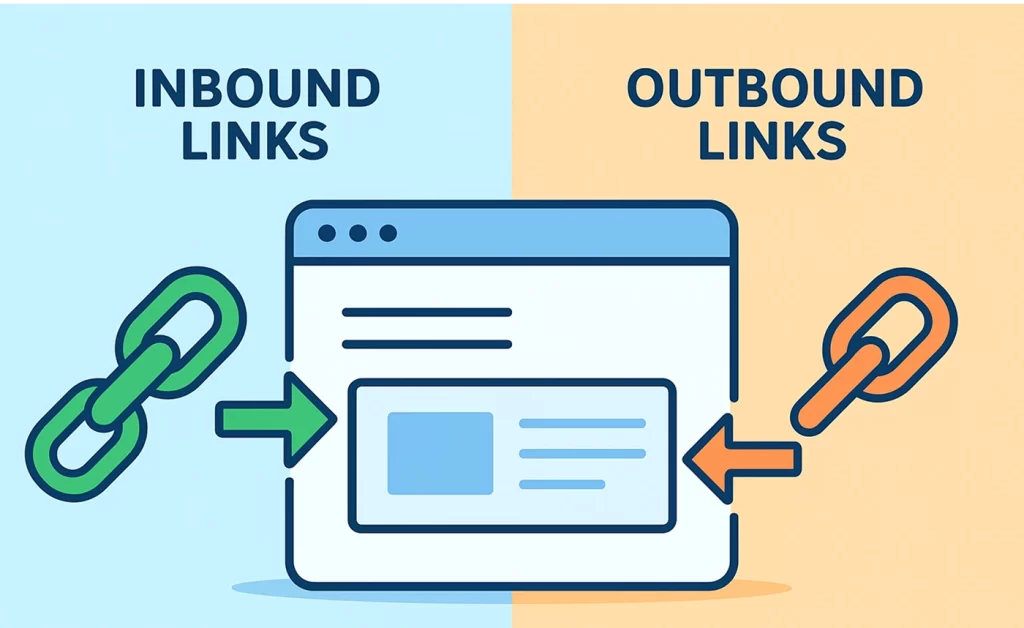Inbound and Outbound Links With Best Practices To Use

Understanding inbound and outbound links is essential for boosting your website’s visibility and improving user experience.
A strong link strategy is one of the most effective ways to boost ranking and gain authority. If you want to rank higher in search results, you need to know how to use both inbound and outbound links smartly.
Links play a major role in improving your position on search engine result pages.
But first, let’s clarify what they mean:
Inbound links are links that point to your website from other websites. For example, if Wikipedia links to https://seobooklab.com/ it will be considered as an inbound link.
Outbound links are links from your website to another website. For example, if https://seobooklab.com/ links to Wikipedia, it is considered an outbound link.

What Is The Difference Between Inbound And Outbound Link
Although inbound links and outbound links may seem similar since both involve backlinks, the key difference lies in their placement.
Inbound links are backlinks that drive traffic from other websites to your site. They pass link equity to your page, which increases its authority and enhances its chances of ranking higher on Google.
Outbound links, on the other hand, are links that you place on your site that point to other websites. In this case, link equity flows from your page to theirs. Instead of losing value, your page gains credibility, momentum, and trust by connecting users with relevant, authoritative sources.
Why Inbound and Outbound Links Matter
You might have heard someone say, “Oh no, outbound links are bad because they take users away from your site.”
But the ultimate truth is that inbound and outbound links are vital for building credibility, improving SEO, and creating a better user experience.
Now, let’s take a deeper look at the benefits of inbound and outbound links.
Improving User Experience
The quality of your website determines how long users stay, and this depends not only on technical factors but also on softer elements of UX.
Internal and external linking guide visitors smoothly through your site, helping them find exactly what they need. Inbound links improve on-site navigation, keeping them engaged and reducing bounce rates.
Outbound links, when directed to authoritative and relevant sources, add extra value, strengthen trust, and enhance your brand’s overall credibility.
Adds Authoritativeness
Now see, there are two conditions. If a site is redirecting to your authoritative and relevant content or you are guiding users to other authoritative content, in both cases, you are upholding your credibility.
If other websites link back to your content, it signals they trust your expertise and view your site as a reliable resource. On the other hand, when you guide users to authoritative and relevant sources, you strengthen your credibility by supporting your arguments with trusted references.
In doing so, you demonstrate to both users and search engines a commitment to fulfilling digital responsibility by delivering the most relevant and authoritative response to user search intent.
Build Loyalty
Every interaction a user has with your content page plays a role in shaping brand loyalty. Your content reflects the brand’s intent, and linking acts as the currency to earn user trust.
Without trust, users will quickly move to a competitor or another path. In one sense, internal and outbound links are opportunities to build that loyalty. Each link should signal, “Click here, and I will give you more value, trust me.”
Over time, consistent content linking often translates into lasting user loyalty.
Improved Conversion Rate
When it comes to call-to-action links, placement isn’t just important; it’s critical. A good anchor text paired with meaningful surrounding content makes your link far more persuasive. Internal linking guides users step by step toward taking an action you want, building momentum with each click.
This works on the “foot-in-the-door” persuasion principle. The idea is simple: if a person says “yes” to a smaller request, they’re more likely to say “yes” to the next, bigger one. A strategically placed link can be that first “yes.”
Once users engage with a smaller link, they’re subconsciously primed to take further actions like signing up, making a purchase, or contacting you.
Supports Search Engine Rankings
There’s an ongoing debate among SEO experts about whether outbound links directly improve search engine rankings. The answer isn’t a simple yes or no. Google has clarified that external links are not a direct ranking factor, yet they indirectly support your rankings in several ways.
First, they help search engines crawl and analyze your site more efficiently.
Second, linking to pages – whether on your site or external – that answer user queries signals relevance, a factor Google considers when ranking pages.
Third, citing trustworthy sources strengthens your content’s credibility, improving user trust.
Together, these practices enhance your site’s authority and relevance, indirectly boosting its search engine performance.
Best Practices for Using Links
Here are a few useful tips to make the most of the linking by following a few simple guidelines
Inbound Links
Earn Them Organically
When building inbound links, focus on earning them naturally. Backlinks should come from relevant, trustworthy websites that genuinely find value in your content. Avoid manipulative or spammy link placements, as they can harm your site’s credibility and disrupt user trust.
Instead, create high-quality, share-worthy content that other sites will want to reference. Relevant inbound links guide new audiences to your site smoothly while boosting your authority and search engine visibility.
Quality and Authoritative Content
Remember, Inbound links work best when they come from quality and credible sources. Don’t just accept any link pointing to your site, vet them carefully.
Avoid spammy, irrelevant, or sensational links, as they can damage your reputation and rankings. Steer clear of sites with poor design, intrusive ads, or endless pop-ups. Focus on earning links from websites that share real value, relevance, and authority in your niche.
Promote Popular Content Pieces
One of the simplest inbound link strategies is promoting your best-performing content. Highlight pages that already attract visitors and engagement, as these are more likely to earn backlinks naturally.
Share them across channels, pitch them to relevant sites, and keep refreshing them with updated insights or stats. By maintaining fresh, valuable, and link-worthy content, you increase its chances of being referenced and linked to by authoritative websites.
Outbound Links
Use Relevant Anchor Text
It is the visible, clickable link within the webpage. It’s easy to think about where you need to place a link, but placing it strategically over a relevant anchor text requires a different strategy.
Use phrases such as “Click here”. Simply give your users a clear idea of what they are going to get when they click on your site. Use relevant keywords wherever possible. Also, it’s a thoughtful gesture to add a parenthetical that guides users whether they are about to visit an image, a PPT, or a PDF, which improves your site’s UX.
Place Naturally
When adding outbound links, ensure they fit naturally within the content. Links should feel like a seamless part of the text, not forced. Avoid placing them in irrelevant sections or within calls to action, as this can distract readers and disrupt their experience.
Focus on contextually relevant links that guide users smoothly, add value, and enhance understanding without interrupting the flow of your content.
Don’t Overdo It
Including outbound links is beneficial, but too many can overwhelm readers and confuse search engines. Keep it balanced to maintain clarity and user experience.
For a typical article, 2 – 4 outbound links per 1,000 words is generally considered healthy. Focus on linking to relevant, authoritative sources that add value, rather than inserting links excessively just for SEO purposes.
Key Takeaways
Links have always been a vital component of SEO strategy and will continue to play a crucial role in the future.
Types of Links:
- Inbound Links (Backlinks): These have the greatest impact on SEO, especially when they originate from high-quality, relevant, and authoritative sources.
- Outbound Links: These enhance your site’s credibility when they point to trustworthy, authoritative websites.
The key to leveraging both types of links effectively is natural placement.
If a link seems out of place or irrelevant to human readers, it’s likely to be viewed the same way by search engines.

